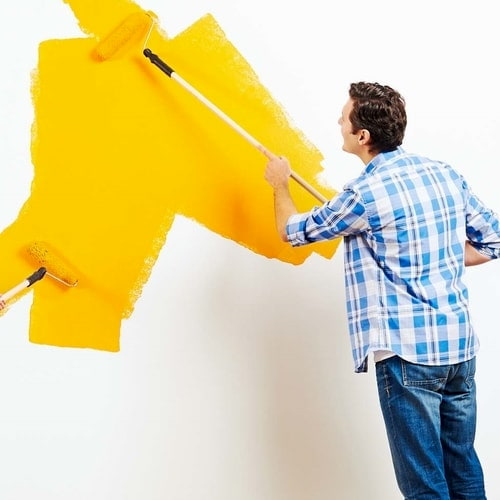How To Paint A Room
Learning how to paint a room the RIGHT way can save you time and money. The ultimate success of your DIY project may depend on the very first step of the process. After all, one of the biggest differences between professional and amateur painters is that professionals recognize and address the importance of proper prepping.

Glidden Spred
Step 1
Choose Your Paint Colors
The first, and possibly the most important, step to painting a room is to choose your paint color or color scheme, and establish the right sheen. The paint color in your space can affect the way you feel every day. Since you likely spend a lot of time in this room, it should be a color that makes you feel happy and relaxed. Of course, it should also complement the rest of your home decor, so take that into consideration as well. Ready to get started?
Paint Tools
Step 2
Buy Paint and Tools
After selecting your paint color(s), the next step is to buy the paint and all the tools. Essential tools include painter's tape, a 2" angled paint brush, a roller, and a paint tray. Other things that might be helpful are drop cloths and a small step ladder.How Much Paint Do You Need?

Choosing the right tools
Choosing The Right Tools And The Right Paint
The secret to a fresh-looking room is ensuring you have the right tools and color. You need to have a painter's brush, roller and tape to make the painting process convenient. A painter's brush is very significant in the painting process. It ensures that you can paint along edges and tight corners.A roller can maneuver through large surfaces in minutes. It ensures that your wall achieves uniformity while painting. Tape is something you cannot miss in your painting supply list if you want perfect results. The tape is used to cover areas such as ceilings, windows or doorways from the paint. You should also ensure that you cover your equipment and floor with drop cloths or newspapers to prevent paint from damaging them.
Find How Much Paint You Need

Enjoy your space painting
Let's Start Painting
If you want to achieve a uniform painting in your room consider starting from the edges using a painter’s brush and then to the large surfaces using the roller. If your bedroom has limited space invest in a mini roller which is easy to navigate on the confined space.After finishing painting your room, you can carefully remove your tape before it sticks on the wall. Leave the paint to dry for sometime before re-occupying your bedroom. If you notice that the painting on your wall is not thick enough, you need to perform some touchups or add another coat to achieve desirable results.
Enjoy Your Space
For proper renewal, you need to ensure that you incorporate fresh paint to make your room feel relaxing. However, you need to select a bedroom paint color that compliments the other places and most importantly your taste. For better results, you can buy sample shades to determine which paint color is suitable for your bedroom. Probably something that compliments the theme of your bedroom would make the room have a fabulous look.
find the right paint for your room

Painting A Room
Step 3
Prep the Room
When learning how to paint a room, you need to know that the pre-painting prep work is important. Begin by taping off anything you don't want to get paint on, such as baseboards and window trim. Remove anything that can be removed, like light fixtures, switch plates and outlet covers. Finally, cover any furniture with drop cloths to protect it from dripping paint.The walls may need to be wiped down with a damp cloth, and be sure to fill any nail holes. Once that has been done, you are ready to use primer (if needed) and start painting. Glidden® Premium Interior Paint Primer can help you shorten painting time.
See All Interior Paints

Painting A Room Wall
Step 4
Paint
Begin by 'cutting in' around the edges of a wall using the 2" angled paint brush. Fill the paint tray with paint, load the roller, and begin rolling until the wall has been covered in paint. As soon as you finish painting the wall, while the paint is still wet, remove the tape so it doesn't get stuck when the paint dries. Move on to the next wall and repeat until the room is painted.It is best to repeat with at least one more coat of paint to get the ultimate coverage, or more if needed. If painting over a dark color, it is best to cover it with a primer first before starting to paint. Also, note that darker colors often require more than two coats to achieve the best results.

Be sure to let the paint dry fully before putting anything back on the wall, like switch plates or wall art.
Now you know how to paint a room, and are, hopefully, no longer feel intimidated by the process. While it does take some time, it is pretty easy, even if you have never done it before.
Find the Right Paint for Your Room
Now you know how to paint a room, and are, hopefully, no longer feel intimidated by the process. While it does take some time, it is pretty easy, even if you have never done it before.
Find the Right Paint for Your Room


